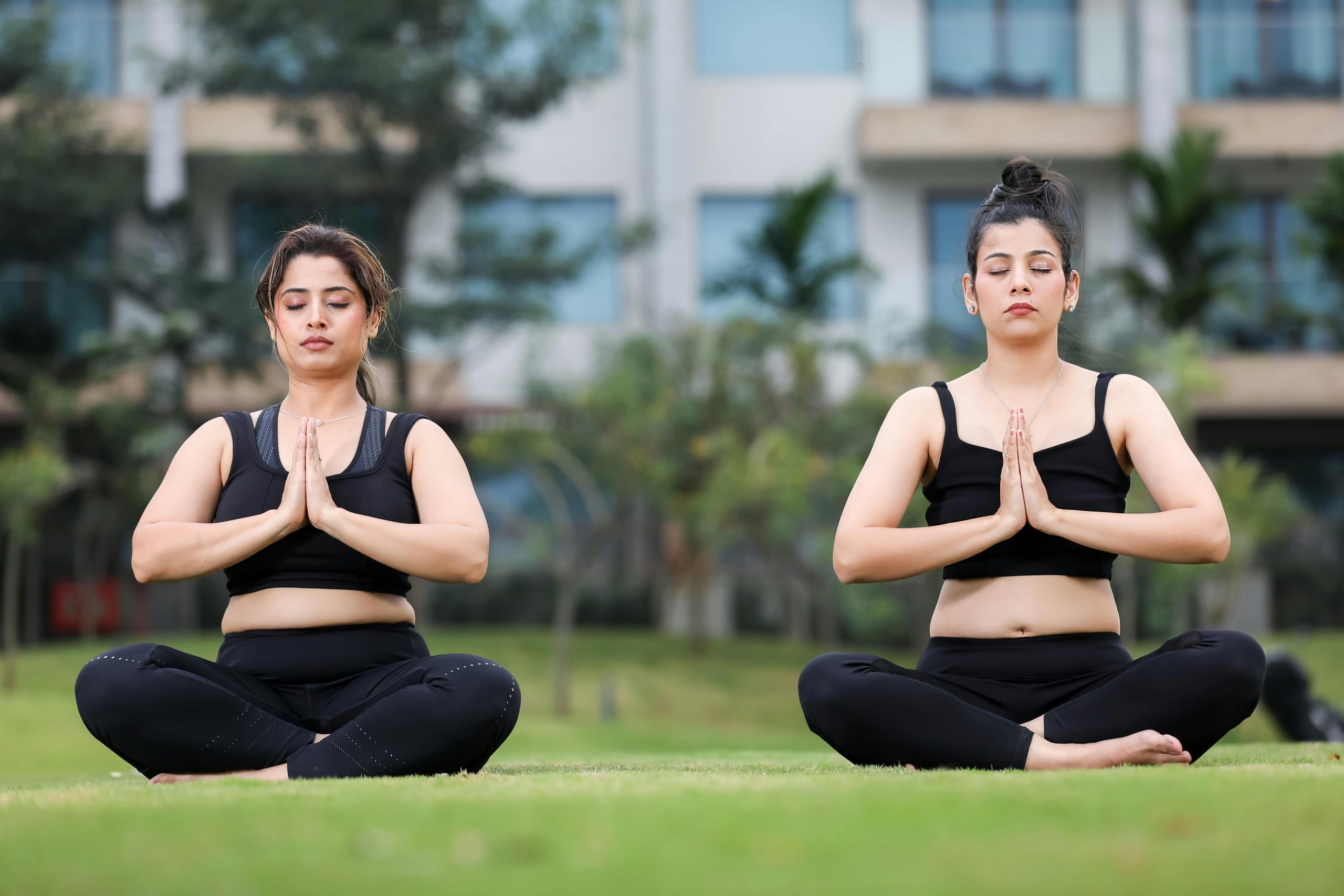Solutions in yoga for backache in females
Yoga offers numerous solutions for alleviating backaches in females. Here are some yoga poses and practices that can help:
-Cat-Cow Stretch (Marjaryasana-Bitilasana): This gentle flow between two poses helps to warm up the spine, increase flexibility, and relieve tension in the back muscles.
-Child’s Pose (Balasana): This resting pose stretches the lower back and hips while providing a gentle release for the spine.
-Downward-Facing Dog (Adho Mukha Svanasana): This pose lengthens and strengthens the spine, stretches the hamstrings, and helps to relieve tension in the back.
Forward Fold (Uttanasana): This standing pose stretches the entire back body, including the spine, hamstrings, and shoulders, while promoting relaxation.
Thread the Needle Pose (Parsva Balasana): This pose targets the muscles along the spine, particularly the thoracic and lumbar regions, helping to release tension and increase flexibility.
Cobra Pose (Bhujangasana): This backbend strengthens the muscles along the spine, opens up the chest, and helps to improve posture.
Bridge Pose (Setu Bandhasana): This pose strengthens the back muscles, opens the chest, and stretches the spine and hip flexors.
Supine Twist (Supta Matsyendrasana): This gentle twist helps to release tension in the spine, improve digestion, and increase spinal mobility.
Seated Forward Bend (Paschimottanasana): This seated pose stretches the entire back body, including the spine, hamstrings, and calves, promoting relaxation and relieving tension.
Supported Fish Pose (Matsyasana): This pose gently stretches the chest and throat while providing support for the spine, helping to alleviate back pain and improve posture.
In addition to practicing these yoga poses regularly, it is essential for femalesexperiencing backaches to maintain proper posture throughout the day, stay hydrated and incorporate other forms of exercise such as walking or swimming to support overall spine health. If the back pain persists or worsens, it is crucial to consult with a healthcare professional for proper diagnosis and treatments.
Effects of the practice of Suryanamaskar on women's health
Surya Namaskar, also known as Sun Salutation, is a popular yoga sequence that combines various asanas (poses) and is known for its benefits on overall health. Here are some potential effects of Surya Namaskar on women’s health:
Physical Fitness: Surya Namaskar can help improve flexibility, strength, and endurance. Regular practice can contribute to a toned and balanced physique.
Weight Management: It can aid in weight management by increasing metabolism and burning calories, which may be helpful for women aiming to maintain a healthy weight.
Cardiovascular Health: The sequence includes brisk movements and controlled breathing, which can have a positive impact on heart health and circulation.
Hormonal Balance: Some women find that regular practice of Surya Namaskar can help regulate hormonal imbalances and alleviate menstrual discomfort.
Stress Reduction: Yoga, including Surya Namaskar, is known for its stress-reducing benefits, which can be particularly beneficial for women managing daily stressors.
Improvement in Posture: The asanas in Surya Namaskar can help improve posture, which is essential for women who spend long hours sitting or have postural issues.
Mental Well-being: Surya Namaskar promotes mental clarity, concentration, and emotional balance, which can be helpful for women in managing mood swings and emotional well-being.
Bone Health: Weight-bearing asanas in Surya Namaskar can contribute to better bone health, which is important for women, especially as they age.
Digestive Health: The practice involves forward and backward bends, which can stimulate and improve digestion.
Breathing Control: The controlled breathing in Surya Namaskar can enhance lung capacity and improve respiratory health.
It is important to note that individual responses to yoga practices like Surya Namaskar may vary. Women should consult with a qualified yoga instructor or healthcare professional to determine the most suitable practice for their specific health and fitness goals.
Pregnant women or those with specific medical conditions should practice yoga under guidance to ensure their safety.
Spiritual effects of suryanamaskar on health and mind
Surya Namaskar, in addition to its physical benefits, is also associated with various spiritual effects on one’s health and mind.
Here are some of the potential spiritual benefits:
Mental Clarity: The meditative aspect of Surya Namaskar encourages mindfulness and focus, which can lead to mental clarity and a sense of inner peace.
Stress Reduction: The rhythmic breathing and movement in Surya Namaskar can promote relaxation, reduce stress, and create a sense of calm.
Enhanced Self-Awareness: Practicing Surya Namaskar regularly can help individuals become more attuned to their bodies, emotions, and thoughts, fostering self-awareness.
Spiritual Connection: For many, the practice of Surya Namaskar is a form of prayer or meditation fostering a sense of connection to a higher power or the universe.
Balanced Energy: Surya Namaskar is thought to balance the solar and lunar energies within the body, promoting a sense of equilibrium and harmony.
Chakra Activation: Some practitioners believe that Surya Namaskar can stimulate and align the chakras, the energy centers in the body, fostering spiritual growth.
Cultivation of Inner Strength: The physical and mental challenges of Surya Namaskar can help individuals develop inner strength, resilience, and a sense of self-discipline.
Transcendence: For those seeking a deeper spiritual experience, Surya Namaskar can be a means of transcending the physical self and connecting with the divine or the higher self.
It is important to note that the spiritual effects of Surya Namaskar can be highly individual and may vary based on one’s beliefs, intentions, and level of practice. Many people find that the combination of physical and spiritual benefits makes Surya Namaskar a holistic practice that promotes overall well-being.
Yogic diet to combat overweight
A yogic diet addressing obesity issues typically emphasizes whole, plant-based foods and mindful eating. Include plenty of fruits ,vegetables whole grains, and legumes.
Opt for light meals, chew food thoroughly, and avoid overeating. Hydrate with water and herbal teas.
Limit processed foods, refined sugars, and heavy meals. Incorporating mindful practices like meditation can complement dietary changes for overall well-being.
Always consult a healthcare professional for personalized advice.
Yoga poses for overweight management
Yoga can be beneficial for managing obesity by promoting physical activity and mindfulness. Poses that focus on strength, flexibility, and relaxation are key.
Some beneficial yoga poses include:
Mountain Pose (Tadasana): Enhances posture and awareness.
Downward-Facing Dog (Adho Mukha Svanasana): Engages various muscle groups and stretches the body
Warrior Poses (Virabhadrasana I and II): Strengthen the legs and core.
Chair Pose (Utkatasana):: Targets the thighs and activates the core.
Bridge Pose (Setu Bandhasana): Strengthens the lower back, buttocks, and thighs.
Child’s Pose (Balasana): Promotes relaxation and stretches the back.
Cobra Pose (Bhujangasana): Strengthens the spine and opens the chest.
Seated Forward Bend (Paschimottanasana): Stretches the spine, hamstrings, and lower back.
Corpse Pose (Savasana): Encourages relaxation and reduces stress.
Remember, consistency is key. It is advisable to consult a yoga instructor or healthcare professional to tailor a practice that suits individual needs and health conditions.
Pranayama to support weightloss programmes
Pranayama, or yogic breathing exercises, can be incorporated into a weight loss routine to enhance overall well-being. While pranayama alone may not directly cause weight loss, it can contribute to a healthier lifestyle by reducing stress and increasing mindfulness. Here are a few pranayama techniques that may be beneficial:
Deep Belly Breathing (Diaphragmatic Breathing): Inhale deeply through your nose, allowing your abdomen to expand. Exhale slowly through your mouth. This can promote relaxation and reduce stress, which may help control emotional eating.
Kapalbhati Pranayama: This rapid, forceful exhalation technique is believed to stimulate the abdominal muscles and improve digestion. However, it’s important to learn and practice this under the guidance of a qualified instructor.
Nadi Shodhana (Alternate Nostril Breathing): This technique aims to balance the left and right sides of the brain, promoting calmness and mental clarity. It can be useful for managing stress-related eating.
Bhramari Pranayama (Bee Breath): Inhale deeply and exhale while making a humming sound. This can have a calming effect on the nervous system and may help in controlling cravings.
Remember, pranayama is just one aspect of a holistic approach to weight management. Combining it with a balanced diet, regular physical activity, and healthy lifestyle choices will yield more effective and sustainable results. Consult with a healthcare professional or yoga instructor for personalized guidance.
Meditation techniques to support overweight management
Meditation can complement weight management efforts by promoting mindfulness, reducing stress, and enhancing self-awareness. Here are meditation techniques that may be beneficial for individuals dealing with weight management issues.
Mindful Breathing: Focus on your breath, inhaling and exhaling slowly. Pay attention to the sensations of each breath. This practice can increase awareness of hunger and fullness cues.
Body Scan Meditation: Progressively scan and relax different parts of your body. This can cultivate a deeper connection with your body and promote a positive body image.
Loving-Kindness Meditation (Metta): Direct positive intentions and compassion toward yourself and others. This practice can foster self-acceptance and a kinder attitude toward your body.
Visualization Meditation: Envision your body in a healthy and vibrant state. Visualization can help create a positive mindset and motivation for making healthier choices.
Awareness of Thoughts Meditation: Observe your thoughts without judgment. This mindfulness technique can be valuable for recognizing and changing negative thought patterns related to body image and weight.
Eating Meditation: Eat mindfully by savoring each bite, paying attention to textures and flavors. This can promote conscious eating and prevent overeating.
Mantra Meditation: Repeat a positive affirmation or mantra related to health and well-being. This can help shift your mindset and reinforce positive habits.
Consistency in meditation practice is key. Start with short sessions and gradually increase the duration. It’s advisable to seek guidance from a meditation instructor or integrate meditation into a comprehensive weight management plan. Always consult with healthcare professionals for personalized advice
Benefits of yoga in PCOD
Yoga can offer several benefits for individuals with Polycystic Ovary Syndrome (PCOS) or Polycystic Ovary Disease (PCOD). PCOS is a hormonal disorder that affects women of reproductive age, and it is characterized by multiple cysts in the ovaries, irregular menstrual cycles, and high levels of androgen hormones. Yoga when practiced regularly and combined with other lifestyle changes, may help alleviate some of the symptoms and improve overall well-being. Here are some benefits of yoga in PCOD:
Hormonal Balance: Yoga practices such as asanas (postures), pranayama (breathing exercises), and meditation can help regulate hormonal imbalances associated with PCOD. Certain yoga poses, like the seated forward bend (Paschimottanasana) and the bridge pose (Setu Bandhasana), can stimulate the endocrine system and help balance hormones.
Stress Reduction: Stress can contribute to hormonal imbalances and worsen PCOD symptoms. Yoga is well-known for its stress-relieving benefits. The practice of yoga postures, deep breathing, and meditation can help reduce stress levels, promote relaxation, and improve overall mental well-being.
Weight Management: PCOD is often linked to weight gain or difficulty in losing weight. Regular practice of yoga can aid in weight management by increasing metabolism, promoting fat loss, and improving overall body composition. Dynamic yoga styles such as Vinyasa or Power Yoga can offer a cardiovascular workout, helping to burn calories and build lean muscle mass.
Improved Blood Circulation: Certain yoga postures, such as inversions like the shoulder stand (Sarvangasana) or legs-up-the-wall pose (Viparita Karani), can improve blood circulation to the pelvic region. Enhanced blood flow may help regulate menstrual cycles, reduce pain, and improve ovarian function.
Enhanced Flexibility and Strength: Regular yoga practice improves flexibility and strengthens the body. It can help tone the abdominal muscles, which is beneficial for individuals with PCOD as it supports healthy digestion, reduces abdominal fat, and improves core strength.
Enhanced Fertility: PCOD can sometimes cause difficulties in conceiving. Yoga combined with other medical interventions, may help enhance fertility by reducing stress, balancing hormones, improving blood flow to the reproductive organs, and promoting overall well-being.
Improved Overall Well-being: Yoga is a holistic practice that benefits the body, mind, and spirit. It can improve energy levels, promote better sleep, boost self-esteem, and increase mindfulness. These positive effects contribute to overall well-being and can have a positive impact on managing PCOD.
It is important to note that yoga should be practiced under the guidance of a qualified instructor, especially when dealing with specific health conditions like PCOD. It is also crucial to consult with a healthcare professional to develop a comprehensive treatment plan that combines yoga with other necessary interventions for managing PCOD effectively.
Dr Neelam Patil





